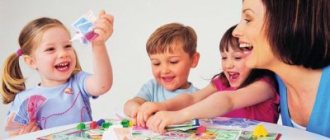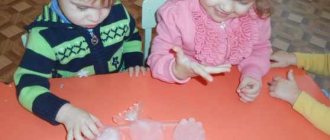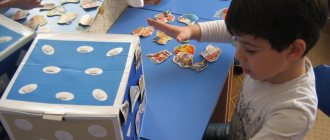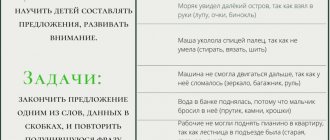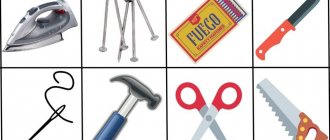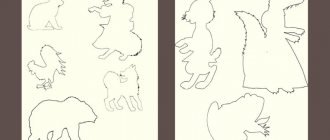The best educational games on the topic “Numbers” for older preschoolers
The didactic game “Numbers” introduces preschoolers to arithmetic, develops memory, logical thinking, and speech skills. Mathematical classes in kindergartens are intended for the older group, that is, for children 5-7 years old. Preschoolers learn to recognize numbers and learn the basics of simple counting in order to come to school with basic knowledge of mathematics.
Grammar tasks
- In what compound words is tr- written instead of three-? (Three-headed, three-lipped, trident, tripod, tripod, triangle, three-legged, etc.)
- How to use the nouns hours, scissors, day with the numerals two, three? (Two/three/four hours, scissors, days.)
- Which ordinal number changes (declines) especially, different from the rest (The third is like a fox.)
- Name the numerals that are written with double consonants. (Eleven, million, billion.)
- What numerals in one of the oblique cases are written with two or even three ь? (Eight, eighty.)
- Name ordinal numbers with two consonant doublings. (Millionth.)
- Which numerals have gender differences? (One, two, and all ordinal ones.)
- Which ordinal numbers are not related to their corresponding cardinal numbers? (First second.)
Problems and games about numbers
This page contains materials for preparing for lessons, competitions, children's Olympiads, and intellectual games on the topic of numerals.
You will find puzzles for finding numerals in poems, games with numbers and words, crosswords and chainwords about numbers. Separate pages contain materials on the following topics:
For some competitions, questions about the names of large numbers are suitable. Below you will find fun and interesting games, puzzles, crosswords about numbers and numerals.
1 Game "Chain". The game can also be played in extracurricular activities. Children sit in a semicircle. The presenter pronounces a combination of a cardinal number with a noun in the indirect case (for example, with two hands), after which the participants in the game pass this word “along the chain”, taking the next numeral in order and selecting a new noun (three days, four chairs).
2 Game “Who is faster?” Combinations are written on the back of the board: 10 tons, 8 floors, 20 kilometers, 1 day, 19 places, 4 engines, 2 humps, 9 knots, 17 meters, 15 apartments, 3 layers, 6 volts, 11 classes, 5 signs, 12 minutes, 16 kilograms, 18 grams. Then the board is turned over, and the children are asked to form a complex adjective with appropriate nouns from these combinations (for example, 10 tons is a ten-ton truck). It is advisable to complete the work in writing.
3 Game "Guess the words." “I know two amazing Russian words,” said Buratino. - One has seven identical vowels, and the other has forty. - Oh, wisest of youths! - Hottabych exclaimed. “You cannot be wiser than me, an old wizard and magician.” I found four more amazing words in the Russian language: each of them has a hundred identical vowels, and there are two “l” in one word. (Answer: seven-ya, forty-a, hundred-ya, hundred-n, hundred-g, hundred-p, two-l)
Card index of games with numbers and numbers according to REMP for preschoolers
Card index of didactic games with numbers and numbers.
Card No. 1.
Game "Confusion".
Target. Strengthen your knowledge of numbers. Develop observation and attention.
Progress of the game.
In the game, numbers are laid out on the table or displayed on the board. The moment the children close their eyes, the numbers change places. Children find these changes and return the numbers to their places. The presenter comments on the children's actions.
Card No. 2.
The game “Which number is missing?”
Target. Strengthen children's knowledge of numbers and the ability to name neighbors of numbers. Develop memory and attention.
Progress of the game.
The game also removes one or two numbers. Players not only notice the changes, but also say where each number is and why. For example, the number 5 is now between 7 and 8. This is not correct. Its place is between the numbers 4 and 6, because the number 5 is one more than 4, 5 should come after 4.
Map No. 3.
Game "What has changed"
Target. Will strengthen the ability to count objects and indicate their quantity with the corresponding number. Develop attention and memory.
Progress of the game.
Several groups of objects are placed on a board or flannelgraph, with numbers placed next to them. The presenter asks the players to close their eyes, and he himself changes places or removes one item from any group, leaving the numbers unchanged, i.e. violates the correspondence between the number of objects and the number. Children open their eyes. They discovered an error and corrected it in different ways: by “restoring” the number that will correspond to the number of objects, adding or removing objects, i.e. changing the number of objects in groups. The one who works at the board accompanies his actions with an explanation. If he completed the task well (find and correct the error), then he becomes the leader.
Card No. 4.
Game "Wonderful bag".
Target. Exercise children in counting using various analyzers. Strengthen ideas about quantitative relationships between numbers. Develop logic, thinking, attention.
Progress of the game.
The wonderful bag contains: counting material, two or three types of small toys. The presenter chooses one of the children to lead and asks to count as many objects as he hears the blows of a hammer, a tambourine, or as many objects as there are circles on the card. Children sitting at tables count the number of strokes and show the corresponding number.
Map No. 5.
Game "How Much".
Target. Exercise children in counting. Develop hearing and attention.
Progress of the game.
6-8 cards with different numbers of objects are fixed on the board. The presenter says: “Now I’ll tell you a riddle. The one who guesses it will count the items on the card and show the number. Listen to the riddle. The girl is sitting in prison, and her scythe is on the street.” The players, having guessed that it is a carrot, count how many carrots are drawn on the card and show the number 4. Whoever raised the number faster becomes the leader. Instead of riddles, you can give a description of the object. For example: “This animal is affectionate and kind, it does not speak, but knows its name, loves to play with a ball, a ball of thread, drinks milk and lives with people. Who is this? Count how many."
Map No. 6.
Game "Count - don't make a mistake."
Target. Fix the order of numbers in the natural series, practice forward and backward counting. Develop thinking and attention.
Progress of the game.
The game uses a ball. Children sit in a semicircle. Before the start of the game, the presenter agrees in what order (direct or reverse) he will count. The presenter throws the ball to one of the players and calls the number. The one who caught the ball continues to count further. The game should be played at a fast pace, and tasks are repeated many times to give as many children the opportunity to take part in it.
Card No. 7.
The game “The toy that disappeared.”
Target. To consolidate the ordinal counting of objects, the concept of “how many”. Develop attention and memory.
Progress of the game.
The presenter displays several different toys. Children look at them carefully and remember where each toy is. Everyone closes their eyes, the presenter removes one of the toys. Children open their eyes and determine which toy is gone. For example, a car hid, it was third from the right or second from the left. The one who answers correctly and completely becomes the leader.
Card No. 8.
The game “Where is it?”
Target. Keep the score within five. Develop memory and attention.
Progress of the game. Models of fruits or vegetables are displayed. The children are counting them. They name where the tomato or apple was. Children check the correctness of their answers.
Didactic games are a type of games with rules, specially created by pedagogy for the purpose of teaching and raising children. However, didactic games are also a game form of education, which, as is known, is quite actively used in the initial stages of education, i.e. in senior preschool and primary school age.
ON THE. Vinogradova noted that due to the age characteristics of preschool children, didactic games, board-printed games, games with objects, verbal and gaming techniques, and didactic material should be widely used for their education.
In my work on the formation of elementary mathematical concepts, I widely use didactic games. After all, we all know that play activity is the leading one in preschool childhood. As V.A. said Sukhomlinsky: “Without play there is and cannot be full-fledged mental development. A game is a huge bright window through which a life-giving stream of ideas and concepts flows into the child’s spiritual world. Play is the spark that ignites the flame of inquisitiveness and curiosity.”
The use of didactic games increases the effectiveness of the pedagogical process; in addition, they contribute to the development of memory and thinking in children, having a huge impact on the mental development of the child. When teaching young children through play, it is necessary to strive to ensure that the joy of play turns into the joy of learning.
In early childhood, the first elementary knowledge of quantity occurs, which is a necessary step in the knowledge of reality. From the first days of life, a child enters the world of objects and phenomena, perceives various quantities of not only objects, but also sounds and movements. The baby develops chaotic, disordered ideas about quantity. Adults help systematize these impressions, teach children various actions with individual objects and groups of objects, enrich their speech with specific words related to the non-numerical characteristics of quantities and quantitative relationships, taking into account the peculiarities of the perception of aggregates.
With proper teaching, children are led to understand the essence of the final number. They begin to distinguish the result of counting from the process of counting and gradually learn that equal groups are called the same number, and where groups are unequal, different numbers are called.
Four-year-old children can count within five, and older children can count within ten. Generally, by the age of six, children master counting to ten and learn the meaning of the final number, but they retain the ability to make mistakes when determining a quantity when visual signs (for example, a change in the location on the table, the size of an object) prevent its correct determination.
This is why it is very important to start preparatory work at a young age. Children should be trained in comparing groups of objects of different shapes, colors, sizes, and differently located.
By the age of six, children begin to understand: each subsequent number is one more than the previous one, and each previous number is less than the next one by one. Preschoolers who have mastered counting discrete aggregates master the ability to count groups of objects (1, 2, 3 pairs).
In the process of developing counting activities, children gradually develop the ability to understand numbers abstractly and prepare for computational activities. Subsequently, preschoolers are introduced to the arithmetic operations of addition and subtraction.
The mental education of a child is associated with his sensory experience, with the development of sensory processes of sensation, perception, and representation.
For perception to be more complete, several analyzers must participate in it simultaneously, that is, the child must not only see and hear, but also act with objects - feel, make various movements. When forming ideas about quantity, special importance should be given to the child’s independent actions. It is necessary to teach children to act with objects: move them left, right, put them together, select them by size, color, shape. These actions contribute to the accumulation of sensory experience about the quantities of various objects.
When organizing children's education, you should:
— to teach preschoolers to observe the actions of adults with objects, to listen to how these actions are characterized in words;
— teach them to act and accompany actions with words;
- encourage children to repeat after adults what is said about the properties and qualities of objects.
Didactic games in the formation of elementary mathematical concepts:
- are one of the sources of mental and speech development.
- contribute to the development of mental processes (attention, memory, thinking).
- facilitate the process of assimilation and consolidation of knowledge.
The main feature of a didactic game is that the task is offered to children in a playful form, which consists of cognitive and educational content, as well as game tasks, game actions and organizational relationships.
The use of didactic games in classes and in free time helps to consolidate children's memory, attention, and thinking. Therefore, in preschool age, a didactic game allows you to form elements of logical thinking, i.e. develop the ability to reason and draw your own conclusions.
An interesting game increases the child’s mental activity, and he can solve a more difficult problem than in class. Play is only one of the methods, and it gives good results only in combination with others: observation, conversations, reading, etc. The game is of great educational importance; it is closely related to
learning in the classroom, with observations of everyday life. They learn to solve game problems on their own and find the best way to accomplish their plans. Use your knowledge and express it in words. Often a game serves as an occasion for imparting new knowledge and broadening one’s horizons. With the development of interest in the work of adults, in public life, in the heroic deeds of people, children begin to have their first dreams of a future profession and a desire to imitate their favorite heroes. Everything makes games an important means of consciousness of the child’s direction, which begins to take shape in preschool childhood. Thus, gaming activity is an urgent problem in the learning process.
Problems
1 Be careful! The teacher writes the following numerals with nouns in brackets on the board. The students' task is to write numerals in words, coordinating them with nouns and using collective numerals where possible. 2 (friend), 5 (feather), 3 (day), 6 (oar), 2 (fork), 5 (broom), 4 (rake), 7 (loop), 9 (pine), 4 (girl), 8 (board), 6 (daughter), 10 (gram), 12 (orange), 7 (tablecloth), 9 (order), 11 (cherry), 13 (village), 15 (hectare), 12 (kilogram).
2 Who is bigger? A) During the given time, you need to write down the largest number of proverbs, sayings, lines of songs and poems containing cardinal numerals. (One in the field is not a warrior. Two boots are a pair. Cry in three streams.) B) You need to select and write down more nouns and adjectives, which include numerals. (Antiform, sixth grade, seven-color, etc.)
